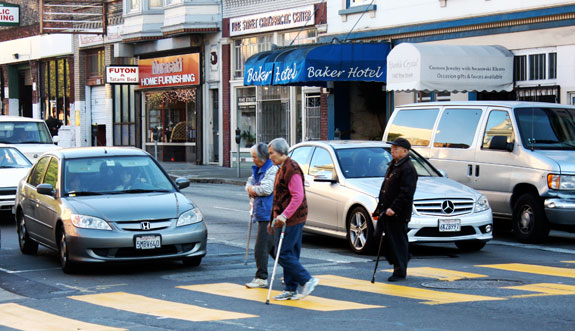A Pedestrian Safety Task Force charged with coordinating and implementing actions to reduce pedestrian injuries and fatalities in San Francisco met for the first time Tuesday, bringing together a large group of representatives from different city departments who rarely sit down at the same table to talk about pedestrian safety.
"I do think that having this many agencies talking about this topic together is a big step forward for the city," said Elizabeth Stampe, the executive director of Walk San Francisco, who attended the meeting.
The task force is the result of an executive directive issued by the Mayor's Office [pdf] in late December that, for the first time, sets specific targets and dates for reducing pedestrian injuries and deaths. The 25-member group must develop a Pedestrian Action Plan that will meet the directive's goals of reducing serious and fatal pedestrian injuries by 25 percent by 2016, and 50 percent by 2021.
Its mission also includes promoting and increasing walking along with "measurable goals and benchmarks" to address "existing disparities in injuries, deaths and walking conditions in San Francisco neighborhoods." The directive was partly modeled after New York's Pedestrian Safety Study and Action Plan, and preceded criticism from advocates that the city was failing to act to improve conditions for pedestrians.
This week's two-hour meeting comes at a time when momentum to address pedestrian issues seems to be building. More than 800 people a year are injured by drivers on the streets of San Francisco and 100 people are killed or severely injured. Those serious injuries create more than $15 million in annual hospital costs, most of it publicly funded through Medicare and MediCal, according to the San Francisco Department of Public Health.
"We've seen a growing focus on pedestrian safety, not only just in San Francisco, but nationwide. More people are walking and more people are going to be doing more walking as our city demographics keep changing," the SFMTA's Deputy Director of Transportation Planning, Timothy Papandreou, told the SFMTA Board recently.
Children, seniors and the poor in neighborhoods like the Tenderloin and SoMa remain the most vulnerable. Supervisor Jane Kim, who represents those neighborhoods and has pledged to make pedestrian safety a priority, will convene a hearing April 7 to address the problem as it relates to District 6. In addition, Supervisor Eric Mar is holding a hearing on citywide pedestrian issues April 11.
Mayor Ed Lee also seems committed to prioritizing pedestrian safety, telling Streetsblog recently that he wants to "'move quickly" on the directive:
“I am a big fan of that executive directive and I am definitely wanting to lower, if not eliminate, pedestrian fatalities. I am even intrigued with designing these streets immediately so that they don’t have car parking at the corner so that you can see the pedestrians come out."
Near-Term Actions
The directive called for short-term actions to be “commenced within 60 days,” including implementing 15 mph speed limit signage at all San Francisco schools, identifying and implementing “home zones” for traffic calming, establishing a pedestrian safety engineering program in corridors and neighborhoods with high pedestrian injuries and fatalities and a pedestrian safety enforcement program lead by San Francisco Police and the Department of Public Health.
In a workshop presentation last month [pdf], Papandreou said the SFMTA has commenced the near-term actions, but some of them, including establishing the 15mph speed limits and creating home zones, may take two to four years to complete. Stampe of Walk SF would like to see them happen sooner.
"MTA should move ahead right away on establishing school zones. MTA should establish as many school zones as possible at once to get protections into place for kids around schools and do it quickly and efficiently," said Stampe, who wants to see the city commit to deadlines for completing the actions as soon as possible.
Another issue is funding, but Papandreou said the SFMTA, the lead agency that will be implementing the action plan, is working on a strategy.
"We really don't have enough funding for the pedestrian program, and it's the hardest source of funding to find for this mode," said Papandreou. "There's transit money for transit, there's highway money for roads but for pedestrian safety, for a city pedestrian project, it's fairly difficult, so we're taking a different tack, and that is, if we focus on complete streets and work on designing pedestrian safety within those streets we should be able to get the funding we need."
Coordinating among all the city departments is also going to be a challenge but Stampe said there seemed to be a willingness to get things done and "that's a positive sign."
"The safety and comfort of pedestrians in this city is finally getting the attention it deserves -- now it's time to translate this energy into real change on the streets," said Stampe.






